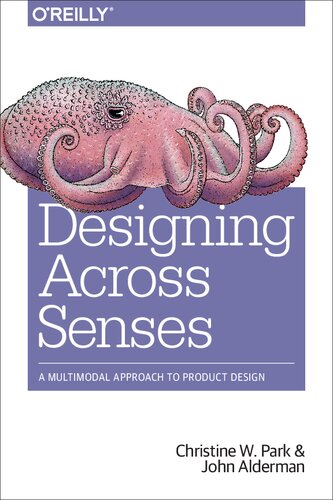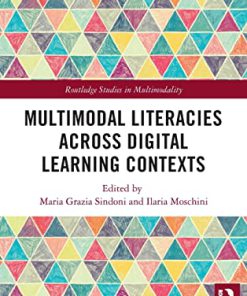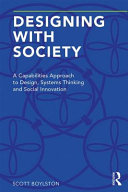Designing Across Senses A Multimodal Approach to Product Design 1st Edition by Christine Park, John Alderman ISBN 1491954191 9781491954195
$50.00 Original price was: $50.00.$25.00Current price is: $25.00.
Designing Across Senses: A Multimodal Approach to Product Design 1st Edition by Christine W. Park, John Alderman – Ebook PDF Instant Download/Delivery: 1491954191, 9781491954195
Full download Designing Across Senses: A Multimodal Approach to Product Design 1st Edition after payment
Product details:
ISBN 10: 1491954191
ISBN 13: 9781491954195
Author: Christine W. Park, John Alderman
Designing Across Senses: A Multimodal Approach to Product Design 1st Edition:
Today we have the ability to connect speech, touch, haptic, and gestural interfaces into products that engage several human senses at once. This practical book explores examples from current designers and devices to describe how these products blend multiple interface modes together into a cohesive user experience.
Authors Christine Park and John Alderman explain the basic principles behind multimodal interaction and introduce the tools you need to root your design in the ways our senses shape experience. This book also includes guides on process, design, and deliverables to help your team get started.
The book covers several topics within multimodal design, including:
- New Human Factors: learn how human sensory abilities allow us to interact with technology and the physical world
- New Technologies: explore some of the technologies that enable multimodal interactions, products, and capabilities
- Multimodal Products: examine different categories of products and learn how they deliver sensory-rich experiences
- Multimodal Design: learn processes and methodologies for multimodal product design, development, and release
Designing Across Senses: A Multimodal Approach to Product Design 1st Edition Table of contents:
1. Returning to Our Senses
- If a Tree Falls in the Forest…
- The Sound of Violence
- Experience Is Physical
- People Have Modalities
- Devices Have Modes
- Human Modalities + Device Modes = Interfaces
- Physical Information: The New Data
- Sensing, Understanding, Deciding, and Acting: The New Human Factors
- Sensing
- Understanding and Deciding
- Acting
- Focus: The New Engagement
- Multimodality Makes a Wider Range of Human and Product Behaviors Possible
- How Multimodality Affects Design
- Creating Usability
- Creating Delight, Trust, and Love
- Multimodal Design Is Cross-Disciplinary
- Summary
2. The Structure of Multimodal Experiences
- The Human Slice of Reality: Umwelt and Sensibility
- Assembling Multimodal Experiences: Schemas and Models
- The Building Blocks of Multimodal Experience
- Summary
3. Sensing
- The Three Main Categories of Stimuli
- Electromagnetic
- Chemical
- Mechanical
- Defining the Senses: Dimension, Resolution, and Range
- Sensory Focus: Selecting, Filtering, and Prioritizing Information
- Reflexes
- Our Senses and Their Unique Properties
- Vision
- Visual Interfaces
- Hearing
- Auditory Interfaces
- Touch (Somatosensory or Tactile Abilities)
- Haptic Interfaces (Tactile, Proprioceptive, and Vestibular)
- Smell (Olfactory Ability)
- Olfactory Interfaces
- Taste (Gustatory Ability)
- Gustatory Interfaces
- Sixth Senses and More
- Time and Rhythm
- Proprioception and the Vestibular System
- Summary
4. Understanding and Deciding
- The Foundations of Understanding: Recognition, Knowledge, Skills, and Narratives
- Aware and Non-Aware: Fast and Slow Thinking
- Agency: Balancing Self-Control and Problem Solving
- Motivation, Delight, Learning, and Reward: Creating Happiness
- Summary
5. Acting
- About Anthropometrics
- The Origin of Anthropometrics
- Task Performance
- Nonverbal Communication
- Precision Versus Strength
- Inferring Versus Designating Intent
- Summary
6. Modalities and Multimodalities
- Modalities: How We Use Our Senses
- Types of Modalities
- We Shape Our Modalities, and They Shape Us
- Attributes and Abilities of Modalities
- Applying Modalities to Design
- Multimodalities
- Trusted Version and Performance Optimization
- Validation
- Integration
- A Single Prioritized Sense or Many Together?
- How Multimodality Shapes Our Activities and Experiences
- Attributes and Abilities of Multimodalities
- Focus
- Flow
- Sequence
- Simultaneity
- Shift
- Transition
- Substitution
- Translation
- Proficiency
- Common Categories of Multimodalities
- Basic Abilities
- Orientation and Scanning
- Hand–Eye Coordination (Visuo-Haptic Integration)
- Social Interaction
- Performance and Athletics
- Cognition and Analysis
- Applying Multimodality to Design
- Maintaining Focus
- Respecting Cognitive Load
- Overcoming Barriers with Substitutions and Translations
- Shifts, Interruptions, and Flow
- Feedback and Validation
- Body Language and Physical Engagement
- Summary
7. The Opportunity: Transforming Existing Products and Developing New Ones
- Key Applications of IoT: Monitor, Analyze and Decide, Control and Respond
- Functional Categories
- Monitor
- Analyze and Decide
- Control and Respond
- Functional Categories
- “Disruptive” Technologies
- Removing Sound—And Putting It Back
- Mapping Apps Know Who Is in the Driver’s Seat
- Beginning Inquiry
- Workflow to Identify Opportunities
- Summary
8. The Elements of Multimodal Design
- Using Physical Information
- Constructing Knowledge, Interactions, and Narratives
- Summary
9. Modeling Modalities and Mapping User Experiences
- Behaviors Shared Between Users and Devices
- Demanding Contexts and Complex Interactions Call for Alignment
- Experience Maps and Models for Multimodality
- Different Maps Cover Different Scopes and Details
- Key Considerations of Multimodal Design
- Modalities and Senses
- Focus
- Level of Focus and Engagement Depth
- Continuity
- Sequence
- Shifts
- Flow and Habits
- Interruptions
- Substitutions
- Specialized Integration
- Knowledge and Skill
- Key Contexts in Multimodal Experiences
- Example Maps and Models
- Experience Map: Transitional Flow
- Ecosystem Map
- Context Map
- Focus Model
- Storyboards and Keyframing
- Update as Needed
- Summary
10. Form Factors and Configurations
- Creating Multimodal Properties
- Configuring Interface Modes
- Mapping Modal Behaviors to Modal Technologies
- Vision Dominant Activities
- Immersive Activities: Screen-Based Experiences and VR
- Augmented or Auxiliary Activities: Visual Indicators for Peripheral Information
- Augmented Reality Versus Augmented Products: Visual Arrays of Control and Choice
- Automated Visual Capabilities
- Creating Focal Experiences with Audio and Speech
- Personal Sound Experiences
- Social Experiences: Broadcast
- Conversation Experiences: Speech
- Creating Haptic Experiences
- Summary
11. Ecosystems
- Device Ecosystems
- Information Ecosystems
- Physical Ecosystems
- Social Ecosystems
- Specialized Ecosystems
- Cloud Architectures: Distributing Resources Through Connectivity
- Ecosystem and Architecture: Applying Ecosystem Resources to Multimodal Design
- Sensing Experiences: Answering the Door—A Doorbell, Ring, and the August Lock
- Understanding and Deciding Experiences: Determining Distance—a Pedometer, Apple Watch, and Lyft App
- Acting Experiences: Writing and Drawing—A Pencil, a Tablet, and the Apple Pencil
- Summary
12. Specifying Modalities: States, Flows, Systems, and Prototypes
- Introduction: A Prototype Is a Custom Measuring Tool
- Practice Makes Perfect
- The Media of Multimodal Products: Information and Interactions, Understandings and Behaviors
- The Product Development Process for Multimodal Products
- Defining Design Requirements
- User Goals, Scenarios and Storyboards, and Use Cases
- Pseudocode and Swimlane Logic Flows
- Specifying Multimodalities
- Synchronous and Asynchronous Modes
- Parallel and Integrated Modes
- Input/Output MAP
- Summary
13. Releasing Multimodal Products: Validation and Learning
- Release Is About Process
- Alpha Release
- Organizing Alpha
- Learning from Alpha
- Beta Release
- Organizing Beta
- Learning from Beta
- Public Release
- Alpha Release
- Validation and Feedback
- The Out-of-the-Box Experience
People also search for Designing Across Senses: A Multimodal Approach to Product Design 1st Edition:
facts about the 5 senses
5 senses facts for preschoolers
5 senses sight activities
design sense touch
design sense meaning
Tags:
Christine Park,John Alderman,Designing,Across Senses,Multimodal Approach,Product Design
You may also like…
Uncategorized
Uncategorized
Multimodal Literacies Across Digital Learning Contexts 1st Edition Maria Grazia Sindoni (Editor)
Arts - Architecture
Reference - Writing
Uncategorized
Engineering - Environmental
Children's Books - Growing Up & Facts of Life












